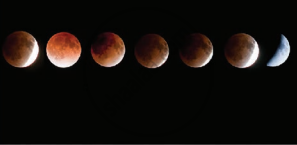Advertisements
Advertisements
प्रश्न
Describe the measurement of Earth’s shadow (umbra) radius during the total lunar eclipse
उत्तर
Lunar eclipse and measurements of the shadow of Earth: On January 31, 2018 there was a total lunar eclipse that was observed from various places including Tamil Nadu. It is possible to measure the radius of the shadow of the Earth at the point where the Moon crosses.

Schematic diagram of umbra disk radius
When the Moon is inside the umbra shadow, it appears red in colour. As soon as the Moon Schematic diagram of umbra disk radius exits from the umbra shadow, it appears in a crescent shape.
By finding the apparent radii of the Earth’s umbra shadow and the Moon, the ratio of these radii can be calculated.
The apparent radius of Earth’s umbra shadow = Rs = 13.2 cm
The apparent radius of the Moon = Rm = 5.15 cm
The ratio `"R"_"s"/"R"_"m"` ≈ 2.56
The radius of Moon Rm = 1737 km
The radius of the Earth’s umbra shadow is Rs = 2.56 × 1737 km ≅ 4446
The correct radius is 4610 km
The percentage of error in the calculation = `(4610 - 4446)/4610 xx 100` = 3.5%
The error will reduce if the pictures taken using a high-quality telescope are used.
APPEARS IN
संबंधित प्रश्न
Explain how Newton arrived at his law of gravitation from Kepler’s third law.
Explain how geocentric theory is replaced by heliocentric theory using the idea of retrograde motion of planets.
Explain in detail the Eratosthenes method of finding the radius of Earth.
The following photographs are taken from the recent lunar eclipse which occurred on January 31, 2018. Is it possible to prove that Earth is a sphere from these photographs?

A student was asked a question ‘why are there summer and winter for us? He replied as ‘since Earth is orbiting in an elliptical orbit, when the Earth is very far away from the Sun (aphelion) there will be winter, when the Earth is nearer to the Sun (perihelion) there will be winter’. Is this answer correct? If not, what is the correct explanation for the occurrence of summer and winter?
The Moon Io orbits Jupiter once in 1.769 days. The orbital radius of the Moon Io is 421700 km. Calculate the mass of Jupiter?
